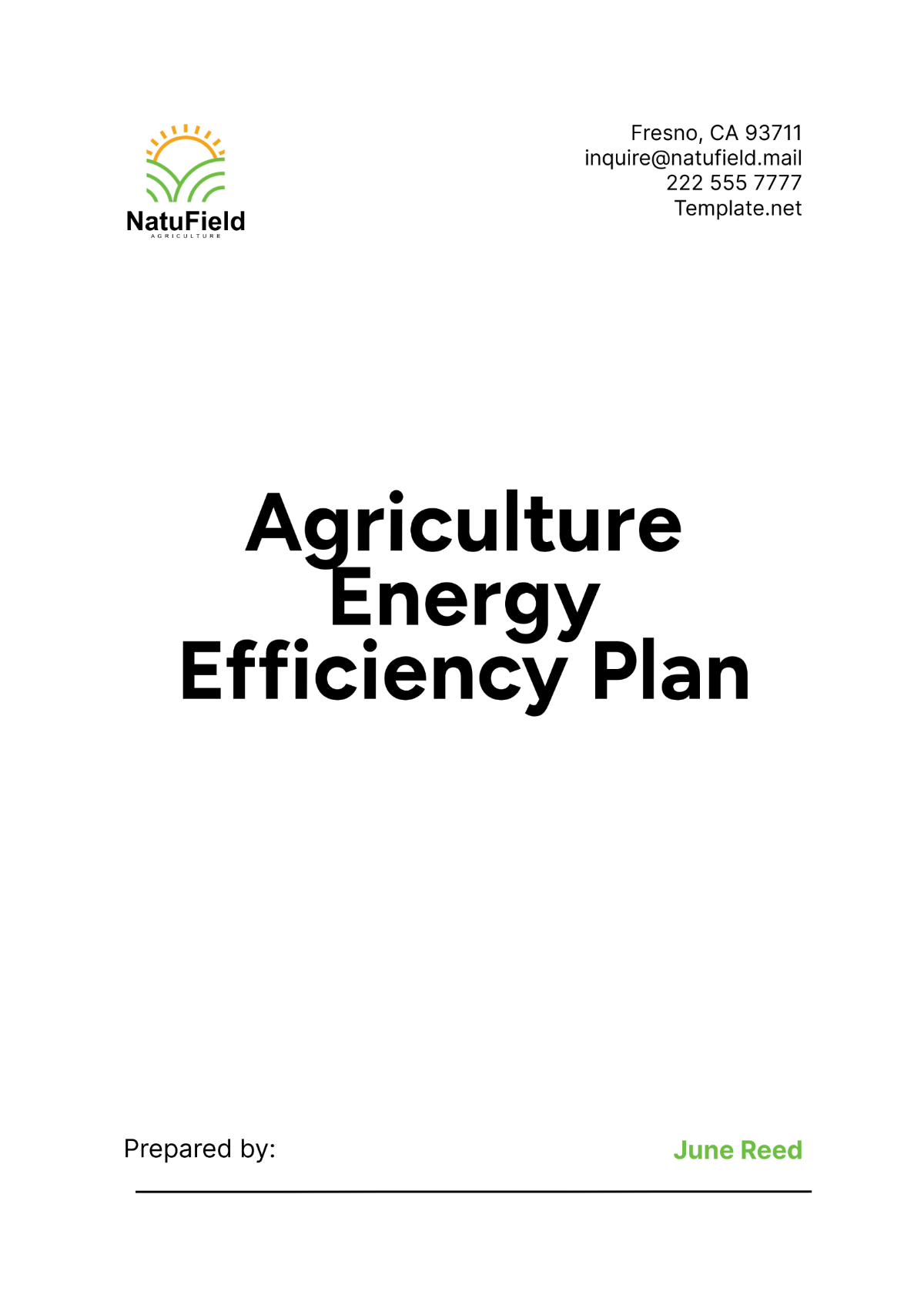Free Agriculture Energy Efficiency Plan

I. Executive Summary
The Agriculture Energy Efficiency Plan developed by [Your Company Name] is a comprehensive strategy designed to enhance energy utilization across agricultural practices. This plan focuses on integrating innovative technologies and sustainable practices to optimize energy consumption and reduce operational costs for farmers. By addressing key areas such as energy-efficient equipment, renewable energy sources, and best practices for energy management, the plan aims to help agricultural operations achieve significant energy savings. It provides a structured approach for farmers to assess their current energy use, implement advanced technologies, and adopt practices that minimize energy waste. Through these measures, the plan seeks to lower greenhouse gas emissions, reduce the carbon footprint of farming activities, and support the transition towards a more sustainable agricultural sector.
In addition to offering practical guidelines, the Agriculture Energy Efficiency Plan provides actionable steps for farmers to improve energy efficiency in their operations. Recommendations include upgrading equipment, optimizing irrigation systems, and leveraging renewable energy sources like solar and wind power. By fostering collaboration between agricultural professionals, energy experts, and policymakers, [Your Company Name] aims to create a more resilient and environmentally-friendly farming industry. The ultimate goal is to enable farmers to reduce energy costs while contributing to broader environmental sustainability objectives, ensuring that agricultural practices meet both economic and ecological standards.
II. Introduction
This section provides a foundational understanding of the significance of energy efficiency in agriculture and outlines the key objectives of the Agriculture Energy Efficiency Plan. By exploring the background of agricultural energy use and setting clear, actionable goals, this plan aims to guide farmers towards more sustainable and cost-effective practices.
A. Background
Agriculture is a fundamental sector of the economy, playing a critical role in food production, rural employment, and economic stability. However, it also represents a significant portion of energy consumption in the economy, with energy used for irrigation, machinery, heating, and transportation. As energy costs rise and environmental concerns intensify, it is increasingly important to focus on improving energy efficiency in agricultural operations. Enhancing energy efficiency not only helps to lower operational costs but also reduces greenhouse gas emissions and environmental impacts. By adopting advanced technologies and sustainable practices, farmers can achieve greater energy efficiency, which is essential for the long-term viability of the agricultural sector.
This plan addresses these challenges by offering strategies to reduce energy consumption and promote environmentally responsible farming practices.
B. Objectives
The primary objectives of this plan include:
Reduce overall energy consumption in agricultural operations by [20]% over the next five years.
Implement renewable energy solutions to cover [50]% of energy needs within ten years.
Educate and train farmers on energy-efficient practices and technologies.
Promote sustainable farming methods to preserve natural resources.
III. Energy Efficiency Measures
This section outlines a series of practical measures designed to enhance energy efficiency in agricultural operations. By implementing these strategies, farmers can achieve significant energy savings, reduce environmental impacts, and promote sustainable practices that contribute to the long-term health of the agricultural sector.
A. Energy Audits
Conducting comprehensive energy audits is a critical first step in identifying inefficiencies and opportunities for improvement in agricultural operations. Energy audits involve a detailed examination of all energy use within the farm, including machinery, buildings, and processes. This process helps identify areas where energy is wasted and provides a basis for developing targeted energy-saving strategies. During the audit, factors such as energy consumption patterns, equipment efficiency, and operational practices are analyzed.
The results offer actionable recommendations for improving energy efficiency, which may include upgrading equipment, modifying practices, or investing in new technologies. Regular energy audits help maintain and enhance energy efficiency over time, ensuring that agricultural operations remain cost-effective and environmentally friendly.
B. Renewable Energy Integration
Adopting renewable energy sources is a key strategy for reducing dependence on fossil fuels and lowering greenhouse gas emissions in agriculture. This subsection highlights three renewable energy solutions that can help farmers meet their energy needs sustainably and economically, contributing to a greener agricultural sector.
Solar panels for powering farm equipment and buildings.
Wind turbines for generating electricity.
Biomass energy from agricultural waste.
C. Energy-efficient Machinery and Equipment
Investing in energy-efficient machinery and equipment is essential for cutting energy costs and enhancing operational efficiency. This subsection explores modern technologies and equipment designed to improve energy use in farming practices, from machinery upgrades to energy-efficient lighting and irrigation systems.
Electric tractors and vehicles.
LED lighting systems for greenhouses and barns.
High-efficiency irrigation systems.
Insulated storage facilities.
D. Sustainable Practices
Adopting sustainable farming practices supports long-term environmental health and energy efficiency. This subsection presents practices that help maintain soil health, reduce chemical use, and optimize resource management, leading to more sustainable and efficient agricultural operations.
Crop rotation and diversified planting to maintain soil health.
Organic farming to decrease chemical use.
Precision agriculture to minimize waste and overuse of resources.
IV. Financial Plan
The Financial Plan section details the projected costs, funding sources, and timelines for implementing the Agriculture Energy Efficiency Plan. This plan is essential for allocating resources effectively and ensuring that each component of the strategy is funded and executed on schedule. The accompanying table provides a comprehensive overview of the financial aspects of the plan, breaking down estimated costs for various energy efficiency measures, identifying potential funding sources, and outlining the expected timeline for each initiative. This structured approach ensures transparency, facilitates financial planning, and helps secure the necessary resources to achieve the plan's goals.
Category | Estimated Cost | Funding Source | Timeline |
|---|---|---|---|
Energy Audits | $[0] | Government Grants | Year 1 |
Renewable Energy Systems | $[0] | Loans and Subsidies | Years 1-3 |
Energy-efficient Equipment | $[0] | Private Investment | Years 1-2 |
Training and Education | $[0] | NGO Funding | Continuous |
Implementation of Sustainable Practices | $[0] | Company Budget | Continuous |
V. Monitoring and Evaluation
Effective monitoring and evaluation are critical for assessing the progress and impact of the Agriculture Energy Efficiency Plan. This section outlines the procedures for tracking performance, measuring success, and making necessary adjustments to ensure the plan’s objectives are met.
A. Performance Metrics
To evaluate the effectiveness of the energy efficiency measures, clear performance metrics are established. These metrics include:
Energy Savings: Measure reductions in energy consumption through pre- and post-implementation comparisons of energy bills and usage data.
Cost Savings: Track financial savings resulting from energy-efficient technologies and practices, including reductions in utility expenses and maintenance costs.
Emissions Reduction: Assess the decrease in greenhouse gas emissions achieved through the adoption of renewable energy sources and improved energy practices.
Adoption Rate: Monitor the number of farms implementing recommended technologies and practices compared to the total number of target farms.
Regularly collecting data on these metrics helps to evaluate the success of each initiative and identify areas for improvement.
B. Reporting and Documentation
Comprehensive reporting and documentation are essential for transparency and accountability. The process includes:
Monthly Reports: Document progress on energy efficiency projects, including completed tasks, challenges faced, and adjustments made.
Annual Reviews: Conduct in-depth evaluations of the plan’s overall effectiveness, including an analysis of performance metrics and financial outcomes.
Final Evaluation Report: At the end of the plan’s term, prepare a final report summarizing achievements, lessons learned, and recommendations for future initiatives.
C. Feedback Mechanisms
Implementing feedback mechanisms ensures continuous improvement:
Farmer Feedback Surveys: Gather input from farmers on the effectiveness of the measures and their satisfaction with the support received.
Stakeholder Meetings: Regular meetings with stakeholders to discuss progress, address concerns, and explore new opportunities for improvement.
These strategies ensure that the Agriculture Energy Efficiency Plan remains effective and responsive to the needs of the agricultural community.
VI. Conclusion
Implementing the Agriculture Energy Efficiency Plan is a transformative step towards optimizing energy use in agricultural operations. By adopting innovative technologies, efficient practices, and renewable energy solutions, the plan aims to achieve significant cost savings while reducing the environmental footprint of farming activities. The strategies outlined in this plan are designed to address current energy challenges in the agricultural sector, offering practical solutions for energy audits, renewable energy integration, and the adoption of energy-efficient machinery. These measures will not only improve energy efficiency but also contribute to long-term sustainability, ensuring that agricultural practices support both economic viability and environmental stewardship.
Successful execution of the plan relies on effective collaboration among stakeholders, including farmers, government agencies, and industry partners. Continuous monitoring and evaluation will be crucial for assessing progress, addressing challenges, and adapting strategies as needed. By working together and staying committed to innovative solutions, we can drive meaningful change in the agriculture sector, paving the way for a more sustainable future. This plan represents a significant opportunity to advance energy efficiency and sustainability in agriculture, fostering a resilient and eco-friendly agricultural industry.
- 100% Customizable, free editor
- Access 1 Million+ Templates, photo’s & graphics
- Download or share as a template
- Click and replace photos, graphics, text, backgrounds
- Resize, crop, AI write & more
- Access advanced editor
Enhance your farm's sustainability with the Agriculture Energy Efficiency Plan Template from Template.net. This editable and customizable template helps you outline energy-saving measures. Editable in our Ai Editor Tool, it allows you to create a tailored plan to reduce energy consumption and costs effectively.
You may also like
- Finance Plan
- Construction Plan
- Sales Plan
- Development Plan
- Career Plan
- Budget Plan
- HR Plan
- Education Plan
- Transition Plan
- Work Plan
- Training Plan
- Communication Plan
- Operation Plan
- Health And Safety Plan
- Strategy Plan
- Professional Development Plan
- Advertising Plan
- Risk Management Plan
- Restaurant Plan
- School Plan
- Nursing Home Patient Care Plan
- Nursing Care Plan
- Plan Event
- Startup Plan
- Social Media Plan
- Staffing Plan
- Annual Plan
- Content Plan
- Payment Plan
- Implementation Plan
- Hotel Plan
- Workout Plan
- Accounting Plan
- Campaign Plan
- Essay Plan
- 30 60 90 Day Plan
- Research Plan
- Recruitment Plan
- 90 Day Plan
- Quarterly Plan
- Emergency Plan
- 5 Year Plan
- Gym Plan
- Personal Plan
- IT and Software Plan
- Treatment Plan
- Real Estate Plan
- Law Firm Plan
- Healthcare Plan
- Improvement Plan
- Media Plan
- 5 Year Business Plan
- Learning Plan
- Marketing Campaign Plan
- Travel Agency Plan
- Cleaning Services Plan
- Interior Design Plan
- Performance Plan
- PR Plan
- Birth Plan
- Life Plan
- SEO Plan
- Disaster Recovery Plan
- Continuity Plan
- Launch Plan
- Legal Plan
- Behavior Plan
- Performance Improvement Plan
- Salon Plan
- Security Plan
- Security Management Plan
- Employee Development Plan
- Quality Plan
- Service Improvement Plan
- Growth Plan
- Incident Response Plan
- Basketball Plan
- Emergency Action Plan
- Product Launch Plan
- Spa Plan
- Employee Training Plan
- Data Analysis Plan
- Employee Action Plan
- Territory Plan
- Audit Plan
- Classroom Plan
- Activity Plan
- Parenting Plan
- Care Plan
- Project Execution Plan
- Exercise Plan
- Internship Plan
- Software Development Plan
- Continuous Improvement Plan
- Leave Plan
- 90 Day Sales Plan
- Advertising Agency Plan
- Employee Transition Plan
- Smart Action Plan
- Workplace Safety Plan
- Behavior Change Plan
- Contingency Plan
- Continuity of Operations Plan
- Health Plan
- Quality Control Plan
- Self Plan
- Sports Development Plan
- Change Management Plan
- Ecommerce Plan
- Personal Financial Plan
- Process Improvement Plan
- 30-60-90 Day Sales Plan
- Crisis Management Plan
- Engagement Plan
- Execution Plan
- Pandemic Plan
- Quality Assurance Plan
- Service Continuity Plan
- Agile Project Plan
- Fundraising Plan
- Job Transition Plan
- Asset Maintenance Plan
- Maintenance Plan
- Software Test Plan
- Staff Training and Development Plan
- 3 Year Plan
- Brand Activation Plan
- Release Plan
- Resource Plan
- Risk Mitigation Plan
- Teacher Plan
- 30 60 90 Day Plan for New Manager
- Food Safety Plan
- Food Truck Plan
- Hiring Plan
- Quality Management Plan
- Wellness Plan
- Behavior Intervention Plan
- Bonus Plan
- Investment Plan
- Maternity Leave Plan
- Pandemic Response Plan
- Succession Planning
- Coaching Plan
- Configuration Management Plan
- Remote Work Plan
- Self Care Plan
- Teaching Plan
- 100-Day Plan
- HACCP Plan
- Student Plan
- Sustainability Plan
- 30 60 90 Day Plan for Interview
- Access Plan
- Site Specific Safety Plan





























